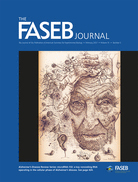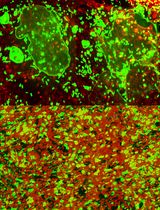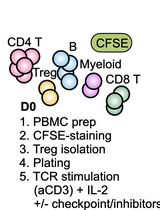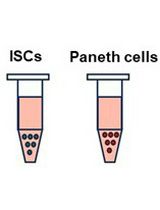- EN - English
- CN - 中文
In vitro Co-culture of Mesenchymal Stem Cells and Endothelial Colony Forming Cells
间充质干细胞和内皮集落形成细胞的体外共培养
发布: 2017年10月20日第7卷第20期 DOI: 10.21769/BioProtoc.2587 浏览次数: 15593
评审: Anonymous reviewer(s)
Abstract
The discovery of endothelial colony forming cells (ECFCs) with robust self-renewal and de novo vessel formation potentials suggests that ECFCs can be an excellent cell source for cardiovascular diseases treatment through improving neovascularization in the ischemic tissues. However, their engraftment after transplantation resulted to be low. Previous studies showed mesenchymal stem/stromal cells (MSCs) could improve the survival and capillary formation capacity of ECFCs in co-culture systems. In this article, we describe a protocol for in vitro co-culture of MSCs and ECFCs to prime ECFCs for better engraftment.
Keywords: Endothelial colony forming cells (内皮集落形成细胞)Background
Endothelial progenitor cells (EPC) are defined as a cell population capable of forming new blood vessels through a vasculogenesis process. In 2004, Ingram et al. identified a specific highly proliferative population of EPC in ex vivo culture termed ‘endothelial colony-forming cells (ECFC)’ from human umbilical cord blood (Ingram et al., 2004) and these cells have recently been declared to represent EPCs (Medina et al., 2017). A similar population can also be isolated from the human term placenta tissue with equivalent vascularization potential and at clinically relevant quantities (Patel et al., 2013; Shafiee et al., 2015). Therefore, ECFC transplantation has been proposed as a therapeutical approach for ischemic diseases such as myocardial infarction or critical leg ischemia. However, ECFCs engraftment and vasculogenic potential after transplantation are well documented to be low (Shafiee et al., 2017; Medina et al., 2017). Previous experiments have shown enhanced ECFC engraftment and function by co-transplantation of mesenchymal stem/stromal cells (MSC) with ECFC (Shafiee et al., 2017). In vitro and in the presence of MSC, ECFC showed enhanced survival in serum deprivation conditions. In normal/growth culture conditions, MSC co-culture resulted in reduced ECFC proliferation and altered appearance towards an elongated mesenchymal-like morphology. Further investigations suggested that direct contact with MSC was required for changes in ECFC morphology and proliferation rate (Shafiee et al., 2017). In addition, after being co-cultured with MSCs for 4 days, ‘primed ECFCs’ showed reduced colony forming potential but improved capacity to form tube-like structures on MatrigelTM in vitro (Shafiee et al., 2017). In this article, we describe a protocol for in vitro co-culturing of ECFCs and bone marrow-derived MSCs (BM-MSCs).
Materials and Reagents
- Materials
- 15 ml centrifuge tube (Corning, Falcon®, catalog number: 352196 )
- 50 ml centrifuge tube (Corning, Falcon®, catalog number: 352070 )
- T75 flasks
- 2 ml micro tubes
- Transwell chambers with a 0.4 µm pore size membrane (Corning, catalog number: 3397 )
- 0.22 μm filter (EMD Millipore, catalog number: SLGP033RS )
- Amicon Ultra-15 Centrifugal Filter Unit with Ultracel-3 membrane (molecular weight cut off, 3 kDa) (EMD Millipore, catalog number: UFC900308 )
- NuncTM 6-well plate (Thermo Fisher Scientific, Thermo ScientificTM, catalog number: 140675 )
- NuncTM 96-well flat bottom (Thermo Fisher Scientific, Thermo ScientificTM, catalog number: 167008 )
- 24-well plates (Thermo Fisher Scientific, Thermo ScientificTM, catalog number: 140644 )
- Culture slides (Corning, Falcon®, catalog number: 354118 )
- Cell strainer (size: 40 μm) (Corning, Falcon®, catalog number: 352340 )
- 20 µl, 100 µl, and 1 ml pipette tips
- 5 ml, 10 ml, and 50 ml serological pipettes
- Cryogenic vials, 1.2 ml (Corning, catalog number: 430487 )
- 50 ml syringe (BD, catalog number: 1018841 )
- Fluorescence activated cell sorting (FACS) tubes (5 ml Round-Bottom Polypropylene) (Corning, Falcon®, catalog number: 352063 )
- FACS tubes (5 ml Round-Bottom Polystyrene, with Cell Strainer Snap Cap) (Corning, Falcon®, catalog number: 352235 )
- 15 ml centrifuge tube (Corning, Falcon®, catalog number: 352196 )
- Cells
- Human MSCs: Adult BM-MSCs were purchased from Lonza (Lonza, USA)
- Human ECFCs: Human fetal placental ECFCs were isolated as reported previously (Patel et al., 2013). To distinguish between MSCs and ECFCs after co-culture, we suggest using GFP tagged ECFCs as used in the current protocol but non-GFP tagged cells can also be used
- Human MSCs: Adult BM-MSCs were purchased from Lonza (Lonza, USA)
- Reagents
- Double-distilled water (ddH2O)
- 100% ethanol
- Dulbecco modified Eagle medium (DMEM) (Thermo Fisher Scientific, GibcoTM, catalog number: 11995073 )
- Fetal bovine serum (FBS) (Thermo Fisher Scientific, GibcoTM, catalog number: 10437028 )
- Phosphate buffered saline (PBS) (Thermo Fisher Scientific, GibcoTM, catalog number: 10010023 )
- PBS tablet (Sigma-Aldrich, catalog number: P4417 )
- TrypLE-express dissociation reagent (Thermo Fisher Scientific, GibcoTM, catalog number: 12605093 )
- Collagen, Type I solution from rat tail (concentrated stock, 100x) (Sigma-Aldrich, catalog number: C3867 )
- Acetic acid (Sigma-Aldrich, catalog number: ARK2183 )
- Endothelial basal medium-2 (EBM-2) (Lonza, catalog number: 190860 )
- Endothelial growth medium-2 (EGM-2) BulletKitTM (Lonza, catalog number: CC-3162 )
Note: The components of this kit includes the following items: Hydrocortisone, GA-1000 (Gentamicin, Amphotericin-B), hEGF, VEGF, hFGF-B, R3-IGF-1, Ascorbic acid, Heparin.
- Growth factor reduced MatrigelTM Matrix (Corning, catalog number: 356230 )
- Dimethyl sulfoxide (DMSO) (Fisher Scientific, catalog number: BP231-100 )
- Secondary antibody goat anti-rabbit Alexa Fluor® 488 conjugate (Thermo Fisher Scientific, InvitrogenTM, catalog number: A-11034 )
- Secondary antibody goat anti-mouse Alexa Fluor® 568 conjugate (Thermo Fisher Scientific, InvitrogenTM, catalog number: A-11004 )
- PE/Cy5 conjugated anti-human CD90 antibody (Thermo Fisher Scientific, eBioscienceTM, catalog number: 15-0909-42 )
- V450 mouse anti-human CD31 (BD, BD Biosciences, catalog number: 561653 )
- 7-Aminoactinomycin D (7-AAD) (Thermo Fisher Scientific, InvitrogenTM, catalog number: A1310 )
- Prolong Gold reagent with 4’,6-diamidino-2-phenylindole dihydrochloride (DAPI) (Thermo Fisher Scientific, catalog number: P36935 )
- Dulbecco’s phosphate buffered saline (D-PBS) (Thermo Fisher Scientific, GibcoTM, catalog number: 14190250 )
- EDTA (Merck, USA, CAS: 6381-92-6)
- Bovine serum albumin (BSA) (Sigma-Aldrich, catalog number: A2153 )
- Paraformaldehyde powder (PFA) (Sigma-Aldrich, catalog number: P6148 )
- 100% Triton X-100 (Fisher Scientific, catalog number: BP151-500 )
- Tween 20 (Sigma-Aldrich, catalog number: P9416 )
- Penicillin/streptomycin 10,000 U/ml (Thermo Fisher Scientific, GibcoTM, catalog number: 15140122 )
- Normal goat serum
- Trypan blue powder
- 70% ethanol (see Recipes)
- Phosphate buffered saline (PBS) (see Recipes)
- Coating solution (see Recipes)
- Complete EGM2 medium (see Recipes)
- Freezing medium (see Recipes)
- FACS buffer (see Recipes)
- 4% paraformaldehyde (PFA) (see Recipes)
- 0.1% Triton X-100 (see Recipes)
- Washing solution (see Recipes)
- Antibodies diluting solution (see Recipes)
- Blocking solution (see Recipes)
- 0.4% Trypan blue solution (see Recipes)
- Double-distilled water (ddH2O)
Equipment
- Water bath
- Refrigerator
- Portable Pipet-aid
- Centrifuge (Eppendorf, catalog number: 5810 R )
- Laminar flow work bench
- Centrifuge
- Shaker
- Tissue culture incubator set at 37 °C, 5% CO2 (Memmert GmbH & Co., Nurnberg, Germany)
- Hemocytometer (Hausser Scientific, catalog number: 3110 )
- IncuCyte Zoom (Essen BioScience)
- Zeiss Axio microscope (Carl Zeiss)
- Fluorescence-activated flow cytometry (FACS) Aria 11u system (BD Biosciences, FACSAriaTM)
- Gallios flow cytometer (Beckman Coulter, Fullerton, CA, USA)
Software
- Kaluza Flow Cytometry Analysis Software
- GraphPad Prism 7 software
- ZEN 2.3 (Blue edition, Carl Zeiss Microscopy GmbH)
- ImageJ (Fiji)
Procedure
文章信息
版权信息
© 2017 The Authors; exclusive licensee Bio-protocol LLC.
如何引用
Shafiee, A. and Khosrotehrani, K. (2017). In vitro Co-culture of Mesenchymal Stem Cells and Endothelial Colony Forming Cells. Bio-protocol 7(20): e2587. DOI: 10.21769/BioProtoc.2587.
分类
干细胞 > 成体干细胞 > 内皮干细胞/祖细胞
发育生物学 > 细胞生长和命运决定 > 血管生成
细胞生物学 > 细胞分离和培养 > 共培养
您对这篇实验方法有问题吗?
在此处发布您的问题,我们将邀请本文作者来回答。同时,我们会将您的问题发布到Bio-protocol Exchange,以便寻求社区成员的帮助。
Share
Bluesky
X
Copy link












